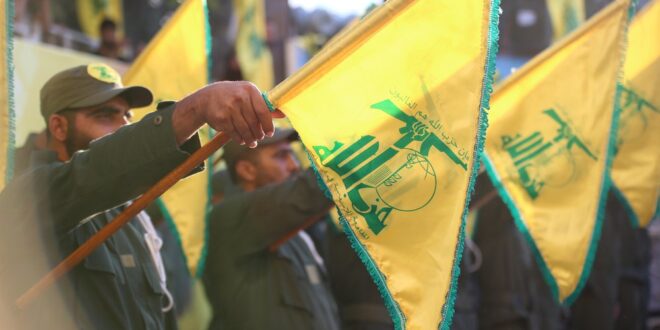As the situation at the Israel-Lebanon border escalates, the room for miscalculation grows.
While the fighting between Israel and Hamas is expected to slow down,developments on the southern border of Lebanon between Hezbollah and Israel suggest that cross-border clashes between the parties heighten the potential of a large-scale war. While U.S. pressure and deployment of aircraft carriers to the eastern Mediterranean have apparently deterred Hezbollah and Iran from escalating the conflict, such developments on the Israel-Lebanon front are stoking fears that any miscalculation or accidents may lead to a wider war.
Since the start of the Israel-Hamas war, Hezbollah and Israel have been exchanging fire along the Lebanon-Israel border. There are growing concerns that the ongoing fighting could slide into an all-out war. Both Israel andLebanon have evacuated tens of thousands of people living along the borders of countries for safety concerns as the crossfire was becoming increasingly deadly. According to several reports, the death toll has been rising, with the conflict leaving eleven Israeli soldiers and civilians dead to date, while over 130 people have been killed in Lebanon, most of them were Hezbollah fighters.
While the fighting has not so far crossed either side’s red lines, its dynamics are altering toward more dangerous escalation. Hezbollah’s attacks are increasing in geographical reach, frequency, and sophistication. Hezbollah first entered the conflict on October 8, a day after Hamas’ deadly assault in southern Israel, by launching rocket attacks at Israeli positions in the Shebaa Farms. But the fight has since expanded and intensified to encompass several border towns. Hezbollah, and to a lesser extent, other militant Palestinian factions, are mounting daily rocket attacks on Israeli positions, while Israel responds with air and artillery strikes. Moreover, according to several reports, in addition to intensifying its waves of rocket and drone attacks on Israeli posts, Hezbollah has also targeted and destroyed various infrastructure underpinning Israeli military positions, particularly surveillance systems. This suggests an anticipation of war on Hezbollah’s end. Media reports appear to highlight Galilean towns in northern Israel as a vulnerable target for Hezbollah, with expectations that Galilee could become a key flashpoint in the conflict.
In turn, since the eruption of the Israel-Hamas war, meetings between Nasrallah and senior Hamas leaders suggest close coordination between the two, reportedly on battlefield developments in Gaza and southern Lebanon. Early in the conflict, several Hamas leaders, including senior official Khaled Mashal, directed harsh criticism against Hezbollah for refusing to open a front on the southern border. However, according to several news outlets, Nasrallah has recently met with senior Hamas leaders following the announcement of the Israel-Hamas truce in November. These meetings discuss the latest events in Gaza, indicating further and ongoing coordination. This likely explains Hezbollah’s halting of cross-border attacks during the truce.
It is often said that Hezbollah’s intention in entering the Israel-Hamas battle is to divert Israel’s attention to its northern front, thus alleviating Hamas of the full brunt of Israel’s war. Notably, almost a month passed before Hezbollah’s Secretary Hassan Nasrallah made his first highly anticipated televised speechabout the war in Gaza. This reflects a considerable measure of caution in deliberating on Hezbollah’s level of involvement in the conflict. In his first speech, Nasrallah did not declare a full-scale war with Israel but warned of its possibility, depending on developments on the Lebanese front and in Gaza. In hissecond speech, a few days later, he seemed intent on underscoring Hezbollah’s leverage in the battle with Israel by highlighting an ongoing and unprecedented level of sophistication in Hezbollah’s operations. However, while Hezbollah’s engagement in the conflict has so far been marked by relative restraint, and most subsequent statements issued by the militia seem to reflect such an approach, generally characterizing its series of attacks as being in “solidarity with Hamas,” many analysts still speculate about Hezbollah’s red line in the conflict, namely the prevention of Israel’s destruction of Hamas.
Almost immediately following Nasrallah’s second speech, Israeli defense minister Yoav Gallant issued a warning to Hezbollah not to escalate the conflict along the countries’ border. This was apparently in response to Nasrallah’s allusion to a heightened scope of military operations. Gallant, along with many senior officials in the Israel Defense Forces, reportedly pushed for launching a pre-emptive major strike against Hezbollah in the immediate aftermath of Hamas’ October 7 attacks. However, the proposal did not gain consensus. U.S. pressure on Israel not to engage in the broader war with Hezbollah has also proven effective. More recently, almost two weeks ago, Israeli government spokesperson Eylon Levy stated that deterrence is Israel’s current policy against Hezbollah rather than engaging in a war. Two days after, though, Israeli Prime Minister Benjamin Netanyahu threatened to destroy Beirut and southern Lebanon should Hezbollah continue its attacks on Israel. This statement was made during a visit to the Israel Defense Forces near the border.
In particular, several recent statements by senior Israeli leaders, including Gallant, Israel’s National Security Advisor Tzachi Hanegbi, Israeli foreign minister Eli Cohen, and other senior Israeli military leaders, suggest that an Israeli preemptive strike against Hezbollah and broadening the war is still a possibility. This is in light of the importance of the security of border towns and the eventual return of its residents following the Hamas assault in southern Israel and its infiltration of security guardrails along border towns.
A powerful indicator is Gallant’s meeting more than a week ago with a group of mayors and heads of councils of border towns. During this meeting, they discussed the potential return of their communities to their homes. Gallant promised that the Israel Defense Forces (IDF) would drive Hezbollah north of the Litani River in Lebanon prior to the residents’ return. Gallant underscored that this could happen either through the enforcement of UN Security Council Resolution 1701, which ended the Israel-Hezbollah war in 2006 and prohibited Hezbollah’s military presence on the southern border, by an international political arrangement, or through military action. In that same spirit, according to the Times of Israel, Israel’s National Security Advisor Tzachi Hanegbi said a few days after that Israel might have to go to war against Hezbollah to pre-empt an attack by the group from the north, similar to Hamas’ October 7 attacks. He reiterated Gallant’s call for the implementation of Resolution 1701. Most recently, on Monday, Israeli foreign minister Eli Cohen said if Hezbollah’s threat on the border with Israel is not removed through diplomatic means, Israel will resort to military action.
In fact, a growing number of Lebanese and international figures are calling for implementing Resolution 1701. These include the head of Lebanese Forces, Samir Gegea; the head of the Kataeb party, Sami Gemayel; and several independent MPs, among others. On the international level, several delegations to Lebanon have urged adherence to Resolution 1701 during talks held with Lebanese senior officials. This urgency transpired during visits from U.S. Special Envoy Amos Hochstein, French Special Presidential Envoy for Lebanon Jean-Yves Le Drian, United Nations Special Coordinator for Lebanon Joanna Wronecka, and most recently, on Monday, French Foreign Minister Catherine Colonna. According to local media, Le Drian, in his recent visit to Lebanon early this month, not only called on Lebanon to implement Resolution 1701 but also warned that if Lebanon does not comply, Resolution 1701 will be implemented through coercion.
Not surprisingly, Nabil Kaouk, a member of Hezbollah’s Central Council, readilydescribed such efforts as promoting Israeli goals inside Lebanon at the expense of its sovereignty. Kaouk went to great lengths to frame the call for Resolution 1701 implementation as an “amendment of Resolution 1701” and part of a plan to create a buffer zone on the border to protect Israeli settlers. However, in response, Hezbollah’s political opponents in Lebanon reportedly clarified that none of the international delegates who visited Lebanon spoke of an amendment to Resolution 1701 instead of its full implementation.
Then, almost two weeks ago, Hamas announced seemingly out of the blue the establishment of a new unit in Lebanon, the Al-Aqsa Flood Vanguards, urging Palestinians in Palestinian camps in Lebanon to join a resistance movement aimed at liberating Jerusalem and the al-Aqsa Mosque. Hamas’ announcement initially prompted condemnation by several Lebanese political circles. Following this, Hamas backtracked, indicating that the launching of the unit was merely a youth mentorship framework for civic engagement in the Palestinian cause.
This move by Hamas was viewed by many as orchestrated by Hezbollah, given its timing and underlying message. Hezbollah is currently facing increasing international and domestic pressure to end its military operations at the border in compliance with Resolution 1701. As Hezbollah critics pointed out, Hamas’ announcement was likely coordinated with Hezbollah and could be interpreted broadly as part of Iran’s maneuver to influence its negotiations with the United States, considering Hezbollah’s total military control in southern Lebanon. This suggests that Iran holds sway over decisions of peace and war in the region. The announcement is also seen as a message that they may dedicate the Lebanese front to Palestinian militants in Lebanon (of course, under Hezbollah’s supervision), from which Palestinian fighters could conduct operations against Israel.
 Geostrategic Media Political Commentary, Analysis, Security, Defense
Geostrategic Media Political Commentary, Analysis, Security, Defense





